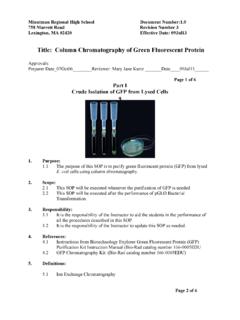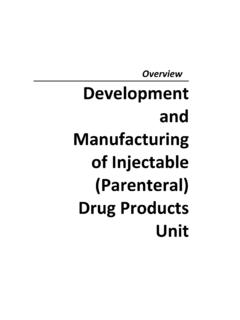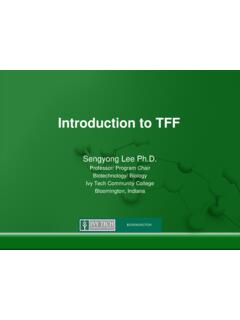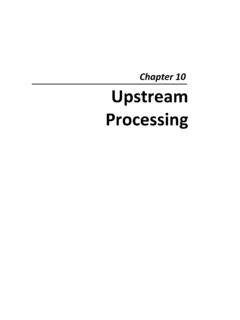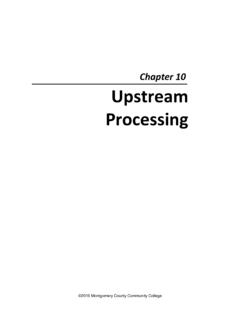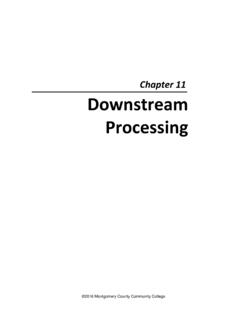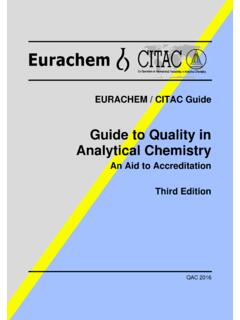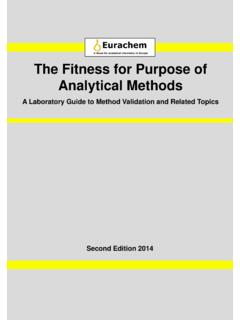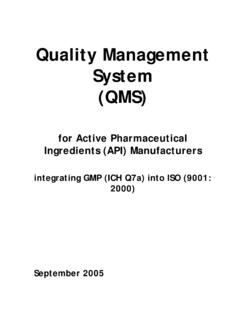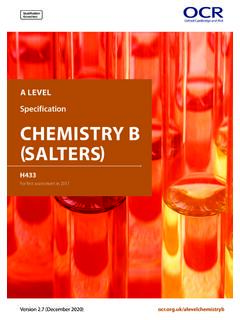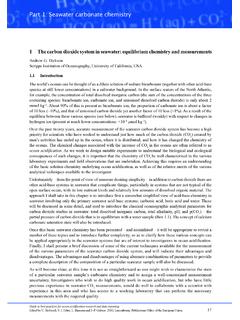Transcription of Chapter 9 Quality Control Biochemistry
1 Chapter 9. Quality Control Biochemistry 2016 Montgomery County Community College Objectives This Chapter provides an overview of the operating principles in Quality Control Biochemistry for biopharmaceuticals. After completing this Chapter student will be able to: Describe a Quality Control (QC) operating system and structure in a biotechnology organization. Define the skills, knowledge, and personnel traits required for QC in a biotechnology organization. List the requirements for data management related to QC. Explain how specifications are used in QC Biochemistry . Describe the techniques used in Biochemistry Quality Control and their application in the biotechnology industry. Define the phases of analytical methods, including development, qualification, and validation. Explain the importance of measurements performed for in-process monitoring, product release, and product stability monitoring. List and explain the requirements of a stability program for a typical monoclonal antibody-based therapeutic.
2 Summarize QC's role in laboratory investigation and the investigation of Out of Specification and Out of Trend results. 342 Chapter 9 - Quality Control : Biochemistry Terms Accuracy: demonstrates the closeness of test results obtained by the method to the true value (nominal) or an acceptable reference value analytical method: a laboratory procedure used to measure a physiochemical entity or attribute of the entity Characterization method: a scientifically-sound analytical test method used to evaluate a specific Quality attribute. They are used in support of cGMP manufacturing, process development, process characterization, formulation development optimization and characterization, deviation investigations, comparability, reference standard qualification, process validation, or other studies required for regulatory submissions Detection Limit (also referred to as Limit of Detection or LOD): the lowest amount of analyte in a sample that can be detected but not necessarily quantitated as an exact value Identity assay: an analytical procedure that confirms the presence of the active product ingredient Impurity detection assay: an analytical procedure that indicates the presence of degradants and other impurities present with the active product ingredient Impurity quantitation assay: a quantitative analytical procedure that measures the amount of degradants or other impurities present with the active product ingredient Intermediate precision.
3 Expresses the precision of a method, under the same operating conditions, when there are intra-laboratory variations involving different days, different analysts, and different equipment Limit of Detection (LOD): the lowest amount of analyte that can be detected but not quantitated as an exact value Limit of Quantitation (LOQ): the lowest amount of analyte that can be quantitatively determined with suitable accuracy and precision Linearity: demonstrates a method's ability (within a given range) to obtain test results directly proportional to the concentration (amount) of analyte in the sample Loading (working) range: an interval of the linear range targeted for sample loading. This range is determined during method development and should provide a proportionate response to main analyte and appropriate sensitivity to other analytes that may be present Performance characteristics: attributes of a method that are evaluated to assure that an analytical method is suitable for its intended use Precision: demonstrates the degree of agreement among individual test results when the method is applied repeatedly to multiple sampling of the same test article under the prescribed conditions; precision as applied to analytical methods has three components: Repeatability, Reproducibility, and Intermediate Precision; precision can be measured as repeatability (intra-assay variability), intermediate precision (intra-laboratory variability), Introduction to Biomanufacturing 343.
4 And reproducibility (inter-laboratory variability). Chapter 4 Metrology covers precision and the related term accuracy Purity assay: a quantitative analytical procedure used to determine the purity of the active product ingredient Purity method: a qualitative analytical procedure used to determine the purity of the active ingredient Qualification: an experimental study demonstrating that an analytical method performs as expected, providing consistent and meaningful data under a defined set of conditions Qualification Result: the result calculated for a particular performance characteristic tested during a Qualification; the reportable Qualification Result is usually determined by statistical analysis of a specified number of reported values Quantitation Limit (also referred to as Limit of Quantitation or LOQ): the lowest (Lower Limit of Quantitation or LLOQ) and highest (Upper Limit of Quantitation or ULOQ) amount of analyte in a sample that can be quantitatively determined with suitable precision and accuracy.
5 The upper and lower limits define the endpoints of the range Range (also referred to as linear or assay range): the interval between the upper and lower concentration (amounts) of analyte in the sample (including these concentrations) for which it has been demonstrated that the analytical procedure has a suitable level of precision, accuracy, and linearity Repeatability: expresses the precision of a method under the same operating conditions over a short interval of time such as performing the test by the same analyst on the same day and using the same experiment set ups. Measures inherent method variability (short time between measurements). Replicate: the determination of a single reported value as prescribed by the method Standard Operating Procedure (SOP). Multiple replicates are treated as individual samples during Qualification studies Reported value: the result obtained by following the testing scheme outlined in the method SOP. Most often the reported value is the average result calculated from a specified number of replicate or individual measurements Reproducibility: expresses the precision between laboratories; demonstrates the measurement of inter-laboratory method variability Robustness: demonstrates the method's ability to remain unaffected by deliberate variations in the method procedure and provides an indication of its reliability under normal operating conditions Specification: an explicit set of requirements or limits to be satisfied by a product when subject to testing 344 Chapter 9 - Quality Control : Biochemistry Specificity: demonstrates the ability of the method to measure an analyte in the presence of components that may be in the sample, including impurities, degradants, and matrix components Standard Deviation: measure of how widely values are dispersed from the average value (mean).
6 Standard Operating Procedure (SOP): a written and approved procedure that is version- controlled and used consistently for cGMP-related testing or operations Validation protocol: defines the scope and procedures necessary to measure the performance of an analytical procedure with respect to specific validation characteristics for its intended use. Predetermined acceptance criteria is set in the protocol for all studies Introduction to Biomanufacturing 345. Introduction to Quality Control in the Biotechnology Industry The active substances in biopharmaceutical medicines are typically large protein molecules that are thousands of times larger than conventional chemical drugs. In the manufacture of biopharmaceutical drug substances, the production processes are typically of extended duration, always involve living cells and complex science and elaborate engineering processes. It is essential that the manufacturer verifies through various types of testing that the process is performing as expected and that the product meets expectations during the entire production process ( all activities are in a state of Control ).
7 Biopharmaceutical Quality Control is based on well-developed scientific methods that make possible relevant measurements of the product stream, the facility, the materials, and the people. Quality Control testing is applied throughout the entire process of the production of biopharmaceuticals. The disciplines involved in biopharmaceutical QC testing include: cell biology virology microbiology inorganic chemistry organic chemistry analytical chemistry molecular biology immunology The evaluation of a biopharmaceutical drug substance coming out of a production run is measured against a specification for that substance. A specification is an explicit set of requirements or limits to be satisfied by a product when subject to testing. For the QC. Laboratory this translates into a defined set of tests and the acceptance criteria associated with each test. Quality Control testing is governed by the product specification. Every batch of the product is tested against the specification. Typical specifications for a biopharmaceutical drug substance and a biopharmaceutical drug product are provided in Table 7-4 of Chapter 7 Quality Assurance.
8 Modern analytical technology has allowed Quality Control testing in the biotechnology industry to advance to a sophisticated level. QC in biopharmaceutical manufacturing goes far beyond the common perception of simple one-step checks of the Quality of a product. Consequently, those who perform this type of work in the biopharmaceutical industry are highly-trained specialists. This ensures that QC tests are performed properly and to exacting standards. In return, these staff members are given job security, job satisfaction, competitive compensation, and continuing opportunities in career growth. 346 Chapter 9 - Quality Control : Biochemistry Introduction to Quality Control Biochemistry As indicated in the overview to this unit, the term Quality Control (QC) can be used to refer to an activity( testing versus a specification) as well as to the actual organizational group who execute this work. QC efforts focus on a product-oriented environment in which analytical methods play key roles.
9 In general terms, QC is a system of checks and measures to ensure that produced material meets certain pre-determined standards. Figure 9-1 illustrates that QC in biotechnology involves multifaceted groups that focus on many aspects of a manufactured product. Each group plays a different role in ensuring that each product is produced to a consistent, high level of Quality . Figure 9-1. The many functions of a QC department Quality Control Responsibilities & Maintaining a State of Control What are QC's responsibilities? The primary responsibility of a Quality Control group is to provide scientific evidence to ensure that products are consistently produced to meet the required purity, safety, and efficacy standards. To meet this primary responsibility, Quality Control staff routinely performs the following activities: Maintenance of the cGMP laboratory: Maintaining a GMP laboratory involves the normal housekeeping activities that would pertain to any laboratory or even to one's home. It also includes ensuring that all equipment is within its calibrated use period.
10 That all solutions, standards, and reagents are labeled, stored appropriately, and within their expiry period; and that all equipment is performing adequately. Introduction to Biomanufacturing 347. QC laboratory documentation system: The work of the QC laboratory involves an abundance of documentation and various documents such as SOPs, forms, training records, etc. which need to be periodically reviewed and updated. Generating testing data and performing data trending: This is the activity performed at the laboratory bench and includes adhering to SOPs by using calibrated and effectively functioning equipment and appropriate materials to obtain and evaluate results. These results are then reported and evaluated for trends. Conducting QC related investigations: If laboratory testing indicates a problem with a batch (or test results are unexpected), a formal investigation must be conducted that leads to appropriate corrective actions. QC also contributes to other groups within an organization.

